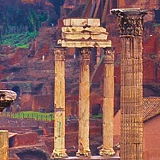
|
Roman Forum Via della Salaria Vecchia, 5/6, Roma, Italy ☎ +39 06 0608 Last Updated: 09/09/2023 |
| The Roman Forum, known in Italian as "Foro Romano," is a historic and archaeological site in the heart of Rome, Italy. It was once the center of political, religious, and commercial life in ancient Rome and is now a prominent archaeological complex that offers visitors a glimpse into the city's rich history. | |
| - Historical Significance: The Roman Forum dates back to the 7th century BC when it was established as a marketplace and meeting place in ancient Rome. Over time, it evolved into the political, social, and religious hub of the Roman Empire. - Location: The Roman Forum is situated in the valley between the Palatine Hill and the Capitoline Hill, two of Rome's famous seven hills. It is located near other historic landmarks, including the Colosseum and the Arch of Constantine. - Architectural Features: The Forum is a sprawling archaeological site that contains the ruins of various structures, including temples, basilicas, government buildings, and monuments. Notable structures include the Temple of Saturn, the Arch of Septimius Severus, and the Temple of Vesta. - Civic and Religious Functions: The Roman Forum served multiple purposes. It was the site of political gatherings, judicial proceedings, religious ceremonies, and commercial activities. It was also the location of important monuments and statues dedicated to various emperors and gods. - Triumphal Processions: Triumphal processions, including those of victorious generals and emperors, often passed through the Roman Forum. These processions showcased the spoils of war and celebrated military achievements. - Transformation: The Forum underwent multiple transformations and renovations over the centuries. It was damaged by fires, earthquakes, and the passage of time, leading to changes in its layout and architecture. - Abandonment: With the decline of the Roman Empire, the Roman Forum gradually fell into disuse and became a site for scavenging and neglect. Many of its buildings were repurposed or scavenged for their valuable materials. - Archaeological Excavations: Extensive archaeological excavations of the Roman Forum began in the 19th century and continue to this day. These excavations have unearthed countless artifacts and have helped reconstruct the site's history. - Visitor Attraction: Today, the Roman Forum is a popular tourist attraction and a UNESCO World Heritage Site. Visitors can explore the ruins, walk along ancient cobblestone streets, and learn about the site's history through informational displays and guided tours. - Palatine Hill: The Roman Forum is often visited in conjunction with the nearby Palatine Hill, one of the Seven Hills of Rome and the traditional site of the founding of Rome. The Palatine Hill offers scenic views of the Forum and the city. - Combined Ticket: Visitors can purchase a combined ticket that allows access to the Roman Forum, Palatine Hill, and the Colosseum, which are all located in close proximity. The Roman Forum stands as a testament to the grandeur and complexity of ancient Rome. It offers a unique opportunity to step back in time and explore the remnants of a once-mighty civilization that had a profound impact on the world's history, culture, and governance. | |
Website Wikipedia
Italy » Rome
Place » Historical Place
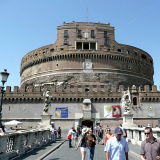
|
Castel Sant'Angelo Place » Historical Place The Mausoleum of Hadrian, usually known as Castel Sant'Angelo, is a towering cylindrical building in Parco Adriano, Rome, Italy. It was initially commissioned by the Roman Emperor Hadrian as a mausoleum for himself and his family. This architectural masterpiece has a rich history that spans nearly two millennia and has served various purposes throughout the centuries. 433 views 💖 10Lungotevere Castello, 50, 00193 Roma RM, Italy |

|
Spanish Steps Place » Historical Place The ‘Spanish steps’ in Rome, built in Rococo style between 1723 and 1726, are the steps that lead from the Piazza di Spagna square to the French monastery church Trinita dei Monti. There are 135 steps and three different terraces, referring to the Holy Trinity. The top of the stairs near the Egyptian obelisk offers a beautiful view, albeit one shared with throngs of other tourists. 16 views 💖 1Piazza di Spagna, 00187 Roma RM, Italy |

|
Rome Place » City Rome is the capital city of Italy. It is also the capital of the Lazio region, the centre of the Metropolitan City of Rome, and a special comune named Comune di Roma Capitale. With 2,860,009 residents in 1,285 km2 (496.1 sq mi), Rome is the country's most populated comune and the third most populous city in the European Union by population within city limits. 84 views 💖 1Italy |

|
Villa Borghese Place » Historical Place Villa Borghese is a magnificent historical park and cultural complex located in the heart of Rome, Italy. It is one of the largest public parks in the city and offers a wide range of attractions, including museums, gardens, a lake, and cultural institutions. 461 views 💖 300197 Rome, Metropolitan City of Rome Capital, Italy |
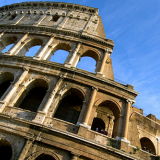
|
Colosseum Place » Historical Place The Colosseum is an iconic amphitheater located in Rome, Italy, and is one of the most recognizable landmarks in the world. Also known as the Flavian Amphitheatre, it was built in AD 70-80 and is considered one of the greatest engineering feats of the ancient Roman Empire. 471 views 💖 10Piazza del Colosseo, 1, 00184 Roma, Italy |
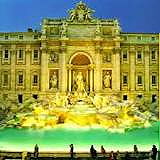
|
Trevi Fountain Place » Historical Place The Trevi Fountain is an 18th-century fountain in the Trevi district in Rome, Italy, designed by Italian architect Nicola Salvi and completed by Giuseppe Pannini and several others. Standing 26.3 metres (86 ft) high and 49.15 metres (161.3 ft) wide, it is the largest Baroque fountain in the city and one of the most famous fountains in the world. 380 views 💖 5Piazza di Trevi, 00187 Roma, Italy |
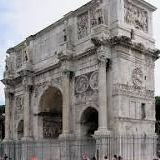
|
Arch of Constantine Place » Historical Place The Arch of Constantine, known in Italian as "Arco di Costantino," is a triumphal arch located in Rome, Italy. It is one of the most well-preserved and iconic Roman triumphal arches, celebrated for its historical significance and intricate reliefs. The arch was commissioned by the Roman Senate to commemorate Constantine's victory over Maxentius at the Battle of Milvian Bridge in AD 312. 400 views 💖 2Via di San Gregorio, Roma, Italy |
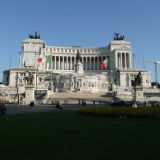
|
Victor Emmanuel Monument Place » Historical Place Officially known as the Monumento Nazionale a Vittorio Emanuele II, the enormous white marble monument that dominates Piazza Venezia was built as a tribute to the first king of a united Italy, Victor Emmanuel II. 425 views 💖 3Altare della Patria, Piazza Venezia, 00186 Roma, Italy |
